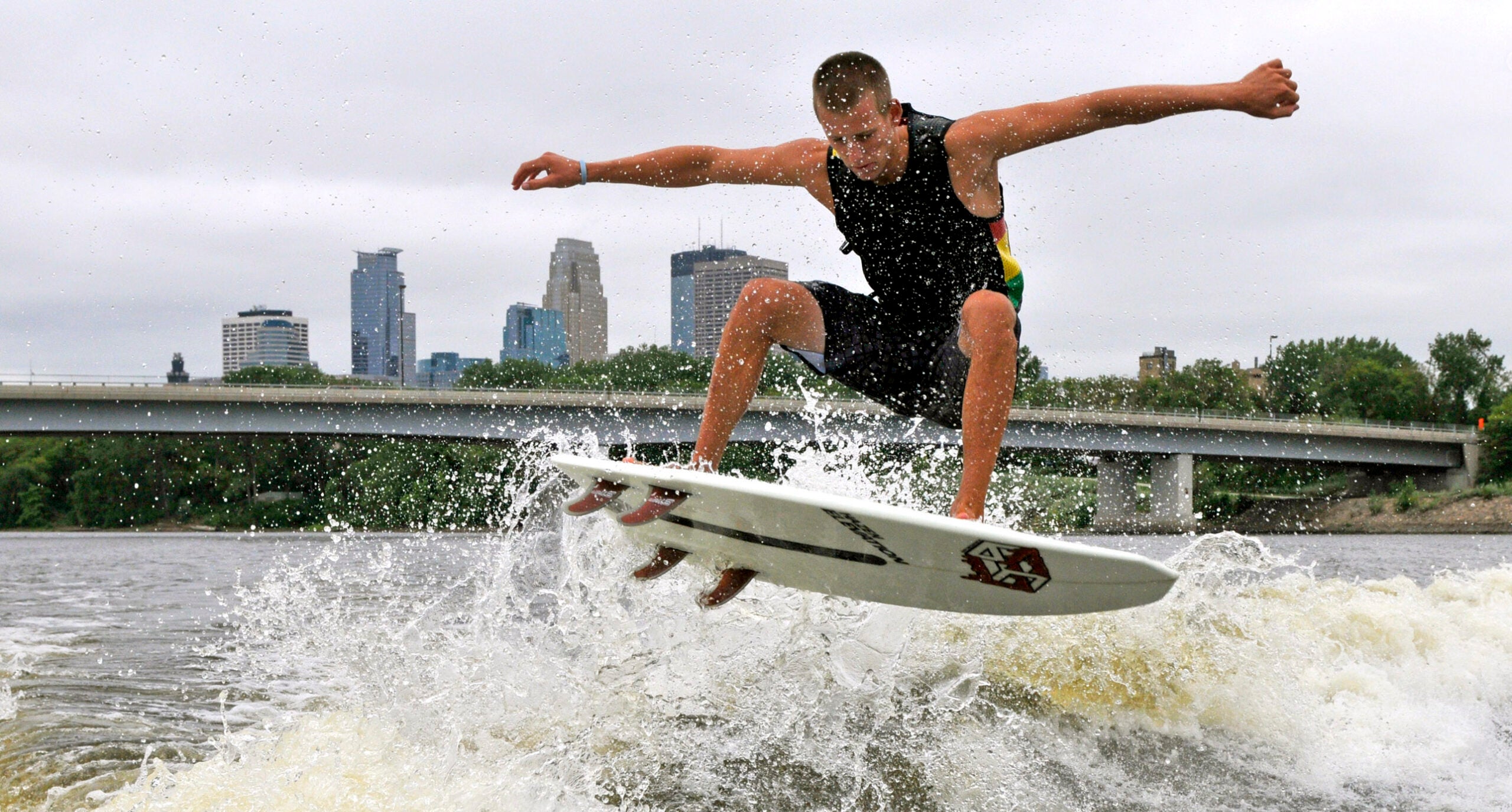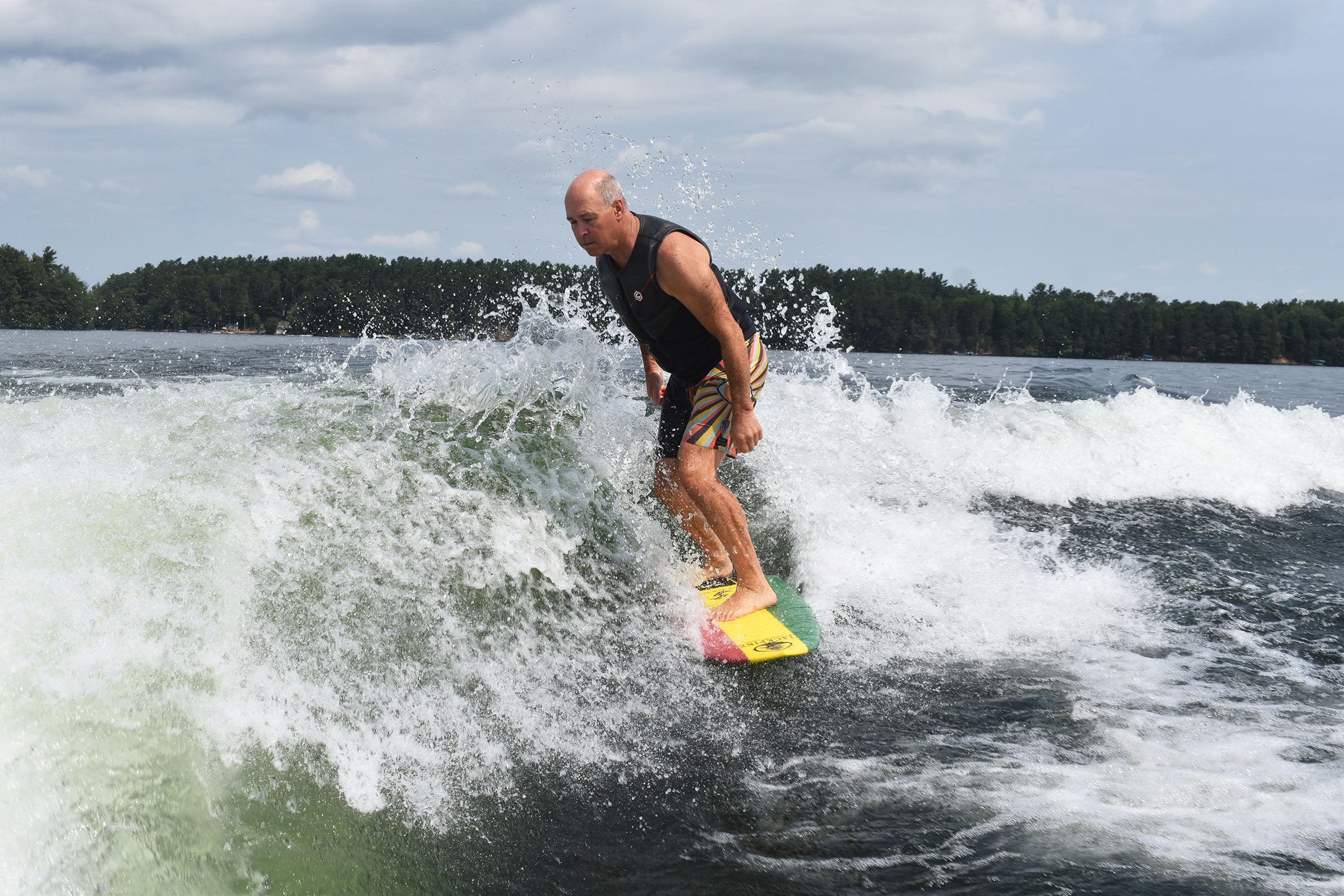In late July, Mike Scandin and Mark Mapes headed out on the waters of Lake Minocqua in a Mastercraft X24 that’s designed for wake surfing. Clouds threatened rain, but the sun peeked out as Scandin guided the boat 800 feet from the shore into an area of the lake about 40 feet deep.
The two have been wake surfing for almost two decades, and they’re co-owners of the wake surfing school Surf Sconsin. Similar to water skiing in that a person is towed behind a boat with a rope, in wake surfing, the person eventually lets go and surfs the large waves created in the boat’s wake.
At 69, Mapes said he got into the sport after his doctors told him to stop water skiing due to an arthritic disease. Now, he said, he surfs five days a week.
News with a little more humanity
WPR’s “Wisconsin Today” newsletter keeps you connected to the state you love without feeling overwhelmed. No paywall. No agenda. No corporate filter.
“It’s a lot of fun. It’s very gentle movements. You’re moving everything in your body to do it, so it helps with agility, coordination,” Mapes said.
Scandin, 59, said he’s no spring chicken either, adding it’s nice that he doesn’t feel any negative effects the next day.
For about the last nine years, he and Mapes have been teaching families and individuals how to wake boat responsibly during the summer. He said that includes surfing in the deepest water possible, far from the shoreline.
But just how far and how deep is at the heart of an issue making waves among users of Wisconsin lakes, and at times pitting neighbor against neighbor.
If boats are too close to the waterfront, Scandin agreed that’s a problem.
“Anyone can be a jerk in a boat,” Scandin said. “It’s not the style of boat that causes the problem.”
Opponents of wake boats say otherwise. The boats are designed to magnify a boat’s wake through ballast tanks or other features, creating the large waves for people to surf. Some critics of the sport say wake boating activities interfere with other forms of lake recreation, such as fishing and canoeing.
Conservation groups argue the boats and their waves pose risks to the environment, public safety and transfer of invasive species. They want such boats to stay 700 feet or more from the shore. The boating industry maintains 200 feet from the shoreline is enough distance to reduce impacts.
In the last year, Wisconsin lawmakers introduced proposals reflecting both recommendations, but the issue remains unsettled as the state sees growing calls for regulation.
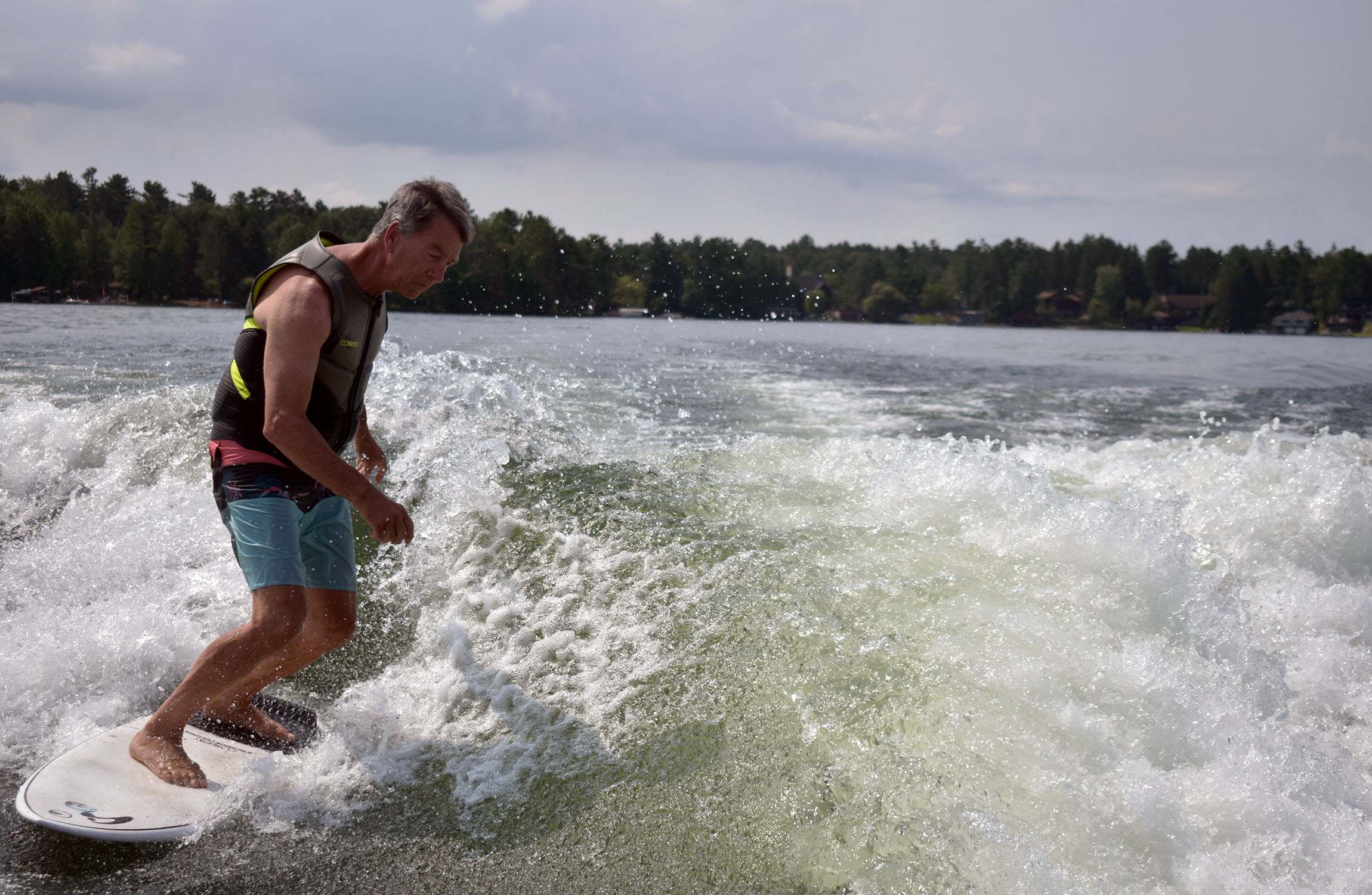
Wake boats can disrupt water recreation, fish habitats
Wake surfers ride waves created by large boats that are about 20 feet or longer, and newer models weigh between roughly 3,000 to 8,000 pounds. As the boats have become more popular, Jeff Meessmann with Last Wilderness Alliance said it’s driving others off the lakes.
“A lot of people have bad experiences with wakesurfing boats, and they don’t want to see them on their lakes because they can’t do anything else,” said Meessmann, chair of the group’s hazardous wake task force.
On smaller lakes, Meessmann said he and others have been unable to fish, paddleboard, kayak or canoe at the same time as wake surfers. Some lake enthusiasts say those who do have gotten hurt or been swamped by waves if they get too close, according to Hans Meyer, vice president of Lakes at Stake.
Beyond that, he and others note the boats typically sit at a higher angle in the water while wake surfing, meaning the propeller creates a jet of water directed toward the lake bottom. One video posted by Last Wilderness Alliance shows a wake boat churning sediments as it passes in a shallow area of Big Cedar Lake in Washington County.
“These boats are stirring up the sediment on the bottom of the lake, so we’re tearing up weed beds. We’re interfering with fish habitat,” Meyer said. “That’s a very serious environmental problem.”
A 2021 study of a lake in Waukesha County found wake boats increased phosphorus levels and produced larger waves that redeposit sediments on the lake bottom. Wake boat operators note the study’s own findings say redistribution of sediments couldn’t be solely attributed to wake boats.
Scandin argued it’s better for wake surfers to be in deeper water of 20 feet or more for safety reasons as well as for the environment. Wake boat operators say there needs to be more tolerance from all lake users, as well as education.
As Mapes surfed on Lake Minocqua, Scandin noted two boats went around the waves.
“It took them five seconds longer to go around us,” Scandin said. “They’re happy. We’re happy. Nobody has a problem with it.”
Rolf and Jennifer Eckert, former Minocqua residents who live in North Carolina, go wake surfing along with their kids Charlotte and Max, who enjoy doing tricks on the water. They said everyone should be mindful of others on the lake.
“We do try to get out early when there’s not a lot of boat traffic, because it’s also better for surfers to be out when there’s not a lot of other traffic,” Jennifer said.
Meyer said one solution may be to carve out times and areas for different users of the lakes.
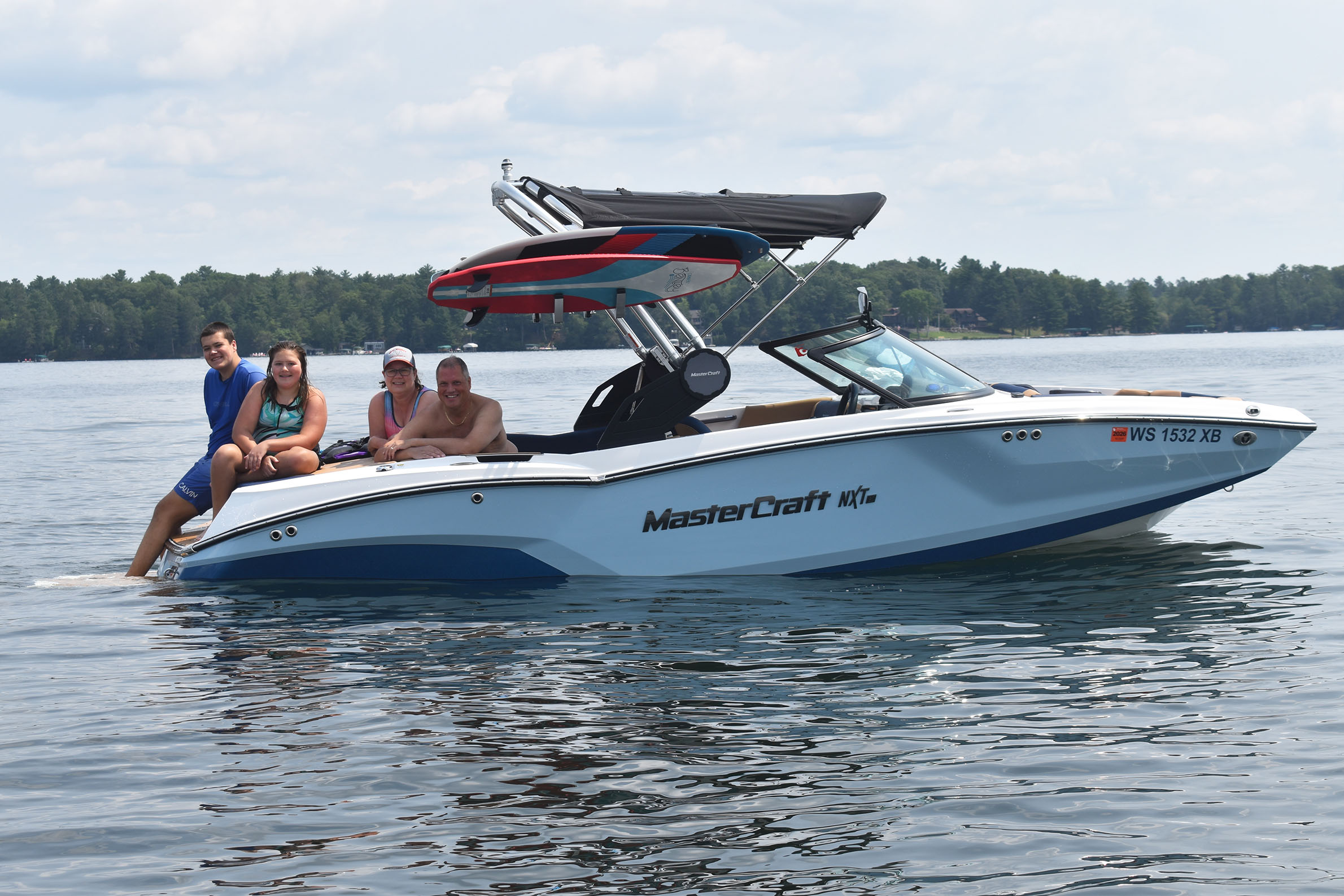
Popularity of wake boating activity spurs studies on effects
The boats have become more popular as people sought the outdoors during the COVID-19 pandemic. In 2020, industry data show sales increased 20 percent to roughly 13,000 units nationwide, making up about 4 percent of new boat sales. Recreational boating creates an $8.4 billion economic impact in the state, according to the National Marine Manufacturers Association.
Wake boats typically operate around 11 mph to create waves between 2 to 3 feet for wake surfing. A recent study from researchers at the University of Minnesota indicates concerns about their effects on shorelines, property and the environment may be justified.
Researchers with the university’s St. Anthony Falls Lab compared wakesurf and other recreational boats under typical operating conditions at a distance of 100 feet from the boats, according to Andy Riesgraf, one of the study’s authors.
The crowd-funded study found wake boats produced maximum waves that were up to three times larger than the waves produced by other boats, with wave energies that were up to nine times greater and the maximum power of waves was up to 12 times larger.
“If you’re wakesurfing, operate your boat a farther distance in the middle of the lake where it’s deeper and farther away from shore to minimize any potential environmental impacts like sediment resuspension or shoreline erosion potential or damage to other people’s property,” Riesgraf said.
The findings show wake boats at wake surf speeds of 11 mph should be more than 500 feet from the shoreline to decrease their wave heights to levels similar to typical recreational boats operating at planing speeds of 20 mph that are 200 feet from shore. When both types of boats are plowing water at wake surf speeds, wake boats would have to be more than 425 feet from the shore to decrease wave heights to levels similar to other recreational boats that are operating 200 feet from shore.
Wake boat supporters dispute those findings. They point to studies funded by the boating industry that found the boats only need to be 200 feet from the shore. Clifford A. Goudey, lead author of a 2015 study, said wakesport waves at that distance fall below those viewed as “exceptional” heights.
“There had been a lot of rumors about these huge waves reaching the shore and doing damage and eroding shorelines,” Goudey said in an interview. “Of course, that can happen, but it does not take much of a distance offshore to greatly reduce that resulting wave height and then the risks of damage.”
However, the study found it took 300 feet for the wave height to drop by half of its original height of 26 inches in waters deeper than 22 feet.
Both supporters and opponents of wake surfing have accused one another of cherry picking data to back up their stance. Neither Goudey’s study nor the one by University of Minnesota researchers examined the effects of wake boats on shorelines.
Goudey said the effect of waves from wake boats often pale in comparison to those from wind-driven waves, but both he and Riesgraf noted boating activity should be avoided near more delicate shorelines that don’t receive winds.
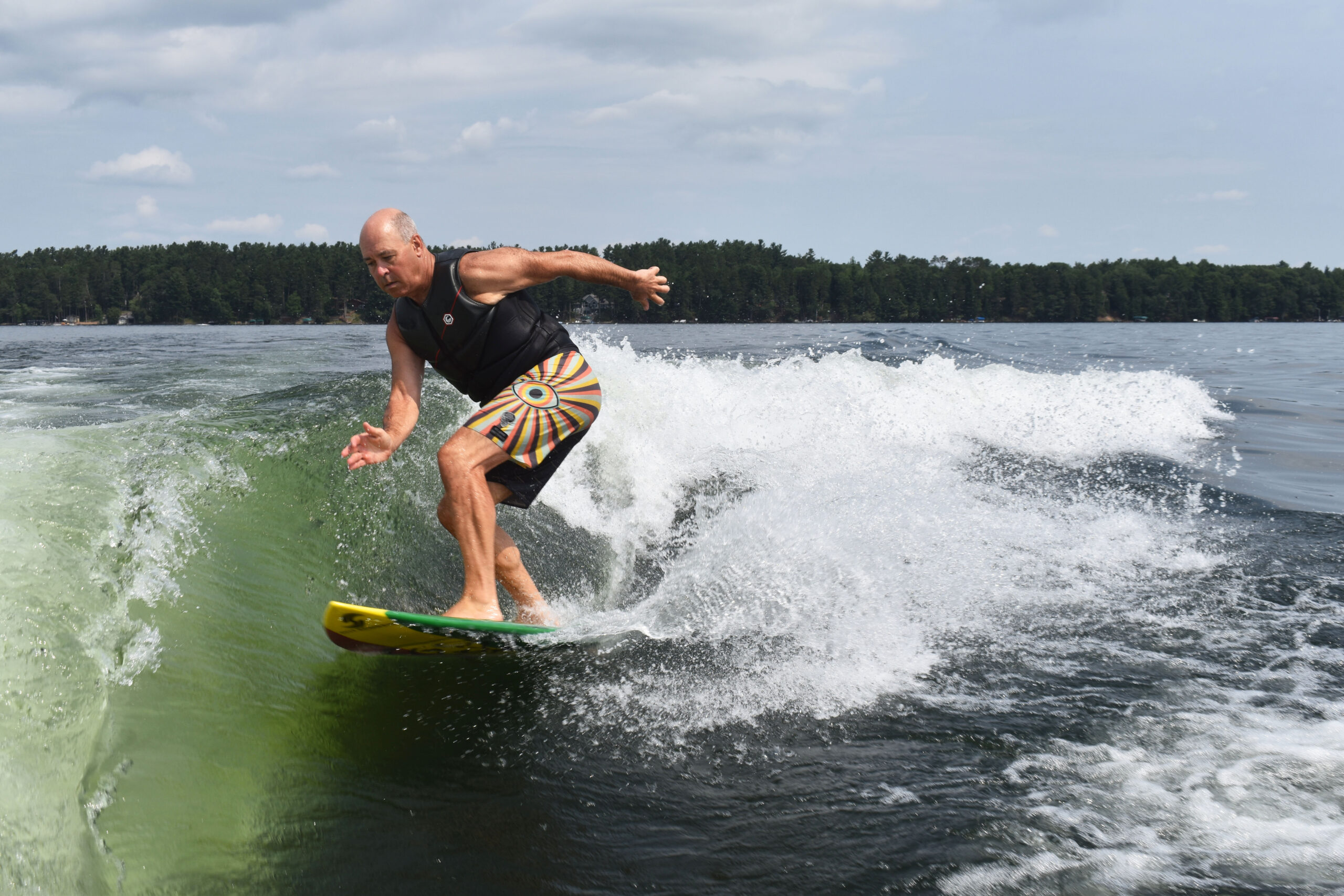
States seek bans, regulations
The growing popularity of wake surfing has sparked debate over how to regulate the boats in states across the country, including Wisconsin. The state of Oregon has banned wake surfing on a popular site of the Willamette River. Earlier this year, Vermont passed a rule that requires wake boats to operate in designated wakesport zones over 500 feet from shore in waters 20 feet deep. A new law in Maine requires a shorter distance of 300 feet from shore in waters at least 15 feet deep.
Last year, the Michigan Department of Natural Resources issued a report reviewing various findings on wake boats that stated waves created by them are an “emerging threat” in inland lakes. The agency recommends boats used for wake surfing operate at least 500 feet from shore in water at least 15 feet deep. Wisconsin’s Green Fire conducted a similar review that concluded wake boating activities should occur 600 feet from shore in water 20 feet deep.
In November, Sen. Mary Felzkowski, R-Tomahawk, introduced a bill supported by the boating industry that would’ve prevented wake surfing within 200 feet of the shore or other structures, but it failed to get a hearing. Felzkowski said in a statement it’s an extremely controversial issue driving a wedge between community members.
“I would have loved to see something get done this past (legislative) session, but very few people were willing to come to the table and have an honest conversation about what we could realistically get across the finish line,” Felzkowski said, adding she looks forward to resolving the issue.
Another bill introduced late in the session by Sen. Andre Jacque, R-DePere, aligned with conservation groups’ recommendations. It also failed to advance.
Wisconsin law currently sets slow-no-wake speeds, the slowest possible speed while minimizing waves, for motorboats within 100 feet of a shoreline, dock or swimmer. State statutes also say no person can operate a motorboat in a manner that will “create a hazardous wake” while approaching or passing other boats.
Even so, conservation groups and leaders in some communities say they can’t afford to wait for state regulation. At least two dozen local ordinances have been passed to regulate wake boats, according to Last Wilderness Alliance.
The town of Presque Isle is among those that passed an ordinance restricting enhanced wakes or waves produced by wake boats. The ordinance bars operation of boats that use equipment like ballast tanks and fins that create large waves on 70 lakes within the town’s boundaries with the exception of Oxbow Lake.
Town Supervisor Cathy Logan Weber said officials feel like they can’t wait for the state to act because of effects on safety, fish habitat and wildlife.
“We’re concerned about wildlife, how it affects the loons that set on their nests and also (aquatic invasive species) being brought from other lakes,” she said.
The Lac du Flambeau Band of Lake Superior Chippewa has banned wake boats on reservation lakes. John Johnson, Sr., the tribe’s president, cited similar concerns about damage to the environment, fish habitat and spread of invasive species as a reason for barring their use.
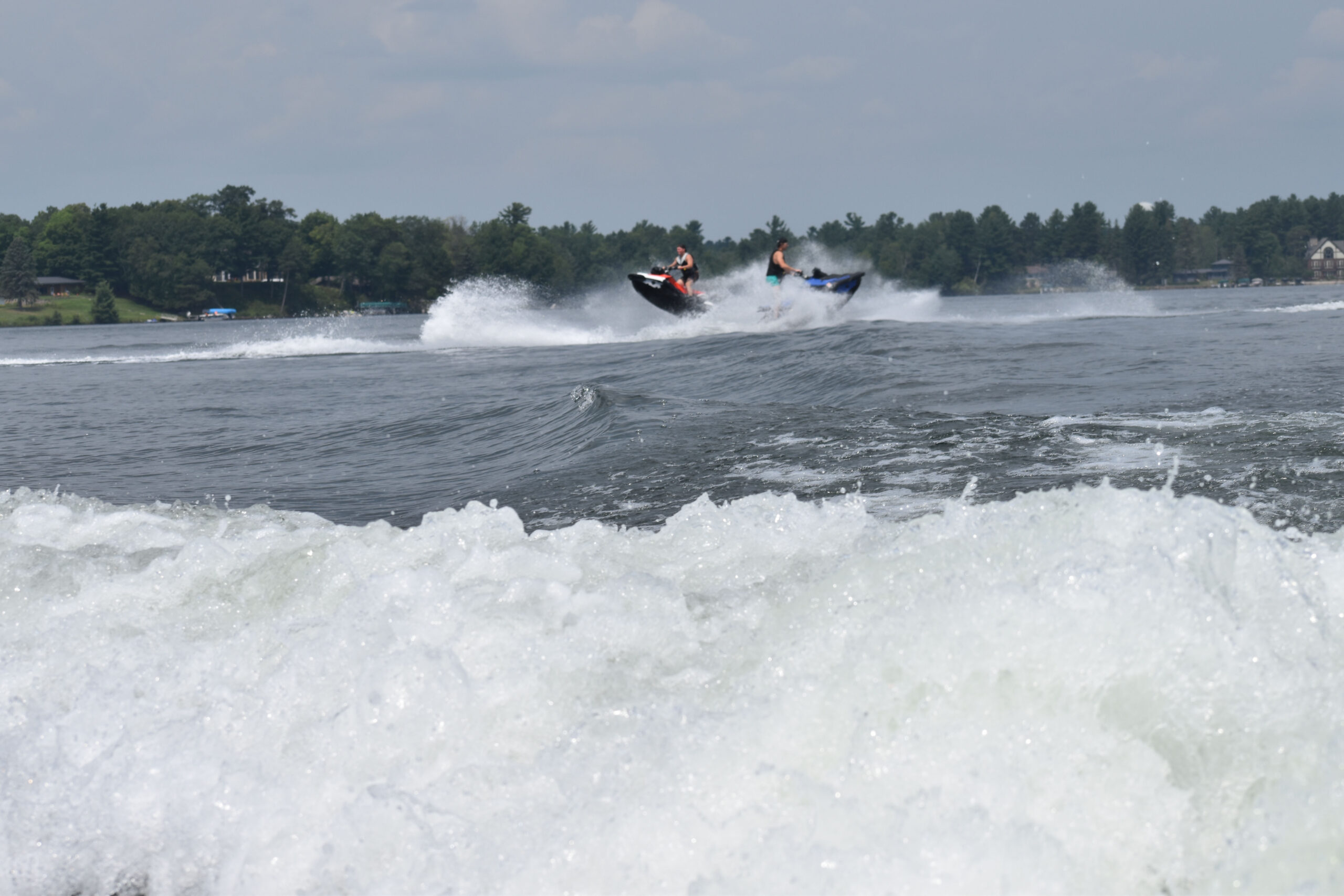
Wake boat design raises questions about spreading invasive species
Wake boat users like Scandin dispute that they carry a special risk of invasive species. Scandin said Surf Sconsin boats bring on ballast and empty water in the same lake. While there may be residual water in the tanks, he noted other boats have also potential to spread invasive species.
One 2016 study by Wisconsin Sea Grant found larvae of invasive mussels in two samples taken from the residual ballast water of 23 wake boats examined, indicating it’s a potential pathway for transporting aquatic invaders.
More than 200 people have filed a petition to adopt a “home lake” rule in Wisconsin similar to Vermont’s regulations that require boats to be used in only one lake each summer and undergo decontamination to limit spread of invasive species.
The Wisconsin DNR has acknowledged that ballast tanks in wake boats are one potential way for invasive species to spread, but the agency notes that aquatic invaders had already become established in hundreds of inland lakes prior to the advent of wake boats. State environmental regulators say more information is needed to better understand their effects on spreading invasive species.
On Wednesday, DNR staff will hold an informational briefing on wake boats, state regulations and consideration of aquatic invasive species before the Natural Resources Board.
Editor’s note: This story has been updated to clarify the findings of the study by researchers at the University of Minnesota.
Wisconsin Public Radio, © Copyright 2025, Board of Regents of the University of Wisconsin System and Wisconsin Educational Communications Board.



